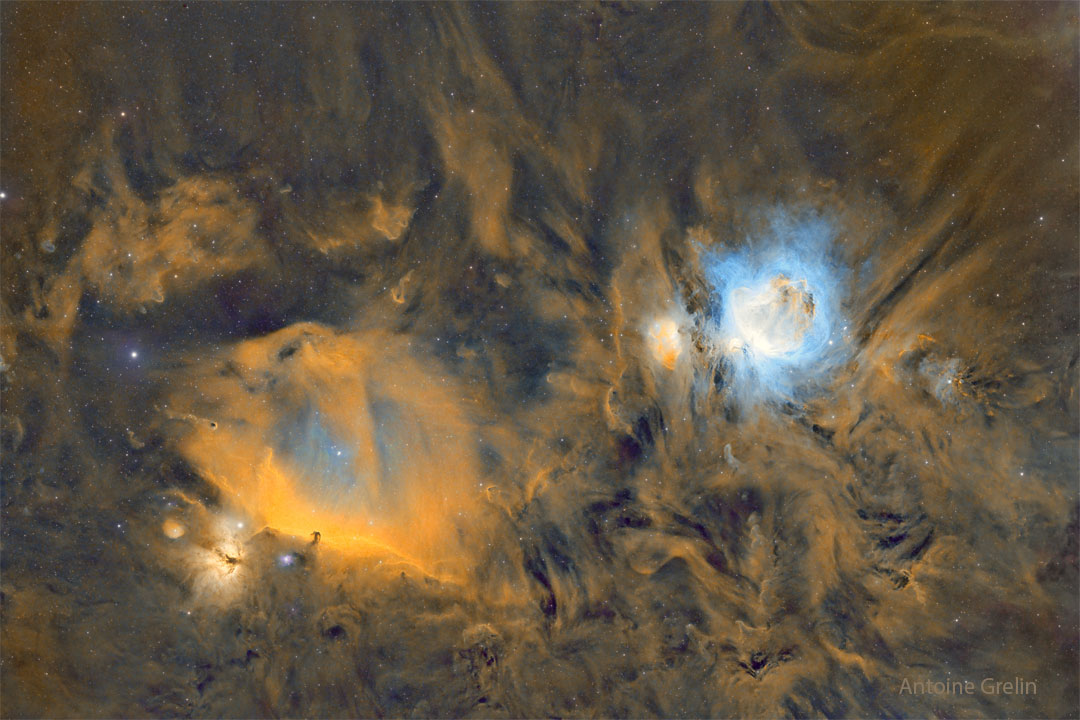Blog




The dark Horsehead Nebula and the glowing Orion Nebula are contrasting cosmic vistas. Adrift 1,500 light-years away in one of the night sky’s most recognizable constellations, they appear in opposite corners of the abovestunning mosaic. The familiar Horsehead nebula appears as a dark cloud, a small silhouette notched against the long glow of hydrogen — here shown in gold — at the lower left. Alnitak is the easternmost star in Orion’s belt and is seen as the bright star to the left of the Horsehead. Just below Alnitak is the Flame Nebula, with clouds of bright emission and dramatic dark dust lanes. The magnificent emission region, the Orion Nebula (aka M42), lies at the upper right. Immediately to its left is a prominent reflection nebula sometimes called the Running Man. Pervasive tendrils of glowing hydrogen gas are easily traced throughout the region.

Mickey Hart (born Michael Steven Hartman, September 11, 1943 Brooklyn, NY) is an American percussionist. He is best known as one of the two drummers of the rock band Grateful Dead. He was a member of the Grateful Dead from September 1967 until February 1971, and again from October 1974 until their final show in July 1995. He and fellow Dead drummer Bill Kreutzmann earned the nickname “the rhythm devils“.
more...
Leo Kottke (born September 11, 1945) is an American acoustic guitarist. He is known for a fingerpicking style that draws on blues, jazz, and folk music, and for syncopated, polyphonic melodies. He has overcome a series of personal obstacles, including partial loss of hearing and a nearly career-ending bout with tendon damage in his right hand, to emerge as a widely recognized master of his instrument. He resides in the Minneapolis area with his family.
Focusing primarily on instrumental composition and playing, Kottke also sings sporadically, in an unconventional yet expressive baritone described by himself as sounding like “geese farts on a muggy day”. In concert, Kottke intersperses humorous and often bizarre monologues with vocal and instrumental selections from throughout his career, played solo on six and twelve string guitars.
more...Victor Lemonte Wooten (born September 11, 1964 Mountain Home, ID) is an American bassist, songwriter, and record producer. He has been the bassist for Béla Fleck and the Flecktones since the group’s formation in 1988 and a member of the band SMV with two other bassists, Stanley Clarke and Marcus Miller. From 2017 to 2019 he recorded as the bassist for the metal band Nitro.
He owns Vix Records, which releases his albums. He wrote the novel The Music Lesson: A Spiritual Search for Growth Through Music. He later released the book’s sequel, The Spirit of Music: The Lesson Continues, on February 2, 2021.
Wooten is the recipient of five Grammy Awards. He won the Bass Player of the Year award from Bass Player magazine three times and is the first person to win the award more than once. In 2011, he was ranked No. 10 in the Top 10 Bassists of All Time by readers of Rolling Stone magazine.
In 2018–2019 Wooten was diagnosed with a rare neurological condition called focal dystonia in his hands and upper body, which had been limiting his ability to play in previous years, but has since abated somewhat.
more...Hiram Law Bullock (September 11, 1955 – July 25, 2008) was an American guitaristknown mainly for playing in jazz funk and jazz fusion, but he also worked as a session musician in a variety of genres.
Bullock was born in Osaka, Japan, to African American parents serving in the U.S. military. At the age of two he returned to Baltimore, Maryland, with his parents and showed musical talent. He studied piano at the city’s Peabody Conservatory of Music, giving his first public performance at the age of six. After playing saxophone and bass guitar, he took up the electric guitar at age sixteen.
Bullock attended McDonogh School for Boys in Reisterstown, Maryland. He was captain of the band in middle school. He studied at the University of Miami, where he met guitarists Pat Metheny and Steve Morse, and bass players Jaco Pastorius and Will Lee. He paid for tuition by performing at nightclubs in Florida before moving to New York. He became best known for playing with Lee on Late Night with David Letterman and working with David Sanborn and Bob James. His work can be heard on Bob James’ Angela which is also the theme song for the TV show Taxi, Steely Dan‘s Gaucho (1980), Paul Simon‘s One Trick Pony (1980), Sting‘s …Nothing Like the Sun (1987) and Billy Joel‘s The Stranger (1977). He also worked with Harry Belafonte, Marcus Miller, Carla Bley, Miles Davis, Ruben Rada, and Gil Evans.
more...Roosevelt “Baby Face” Willette (September 11, 1933 – April 1, 1971) was an American hard bop and soul-jazz musician who played the Hammond organ.
He was born Roosevelt James Willett (no “e”), in Little Rock, Arkansas, in 1933 according to researchers Bob Eagle and Eric LeBlanc, though other sources state 1934 or 1937. According to the liner notes on his first Blue Note album, Grant’s First Stand, Willette was born in New Orleans.
His mother was a missionary who played the piano in the church where his father was a minister. As a result, his musical roots were in gospel. Willette became involved in music by playing the piano for various gospel groups, and accompanied his sisters Dorothy and Georgia, who toured and recorded as the Willett Sisters. He spent his early career travelling across the United States, Canada and Cuba, as pianist with the bands of King Kolax, Joe Houston, Johnny Otis and Big Jay McNeely, among others.
He made his first recording as Baby Face Willette (“Wake Up, Get Out” b/w “Cool Blues”) in Los Angeles in 1952, but soon moved to Chicago and married. He recorded tracks including “Can’t Keep From Lovin’ You” and “Why” for Vee-Jay Records that year, but they were not released until late 1955. He played in both rhythm and blues and jazz bands, playing piano before switching to organ around 1958. His organ playing was inspired by Jimmy Smith‘s work, though Willette’s style is more heavily influenced by gospel, blues and soul jazz than Smith’s. Willette was also a professional hairdresser. Before his time in New York City, he was based out of Milwaukee, playing with his vocalist wife Jo Gibson at clubs such as The Flame Club, The Pelican Club, The Moonglow and Max’s among others.
more...The subject of this Hubble Picture of the Week is a spiral galaxy in the constellation Virgo named NGC 5668. It is relatively near to us at 90 million light-years from Earth and quite accessible for astronomers to study with both space- and ground-based telescopes. At first blush, it doesn’t seem like a remarkable galaxy. It is around 90 000 light-years across, similar in size and mass to our own Milky Way galaxy, and its orientation nearly face-on to us shows open spiral arms made of cloudy, irregular patches.
One noticeable difference between the Milky Way galaxy and NGC 5668 is that this galaxy is forming new stars 60% more quickly. This fact belies a galaxy with churning clouds and flows of gas, inclement weather that forms excellent conditions for the formation of new stars! Two main drivers of star formation have been identified by astronomers. Firstly, this high-quality Hubble snapshot reveals a bar at the centre; it might look more like a slight oval shape than a real bar, but it appears to have impacted the galaxy’s star formation rate, as central bars do in many spiral galaxies. Secondly, high-velocity clouds of hydrogen gas have been tracked moving vertically between the disc of the galaxy and the spherical, faint halo which surrounds it. These can be produced by the strong stellar winds of hot, massive stars, and they contribute gas to new star-forming regions.
The enhanced star formation rate in NGC 5668 comes with a corresponding abundance of supernova explosions. Three have been spotted in the galaxy, in 1952, 1954 and 2004. In this image, Hubble was used to examine the surroundings of the Type II SN 2004G, seeking to study the kinds of stars that end their lives as this kind of supernova.

Roy James Brown (September 10, 1920 or 1925 – May 25, 1981) was an American blues singer who had a significant influence on the early development of rock and roll and the direction of R&B. His original song and hit recording “Good Rockin’ Tonight” has been covered by many artists including Wynonie Harris, Elvis Presley, Bruce Springsteen, Paul McCartney, Joe Ely, Ricky Nelson, Jerry Lee Lewis, Pat Boone, James Brown, the Doors, and the rock group Montrose. Brown was one of the first popular R&B singers to perform songs with a gospel-steeped delivery, which was then considered taboo by many churches. In addition, his melismatic, pleading vocal style influenced notable artists such as B.B. King, Bobby Bland, Elvis Presley, Jackie Wilson, James Brown and Little Richard.
more...José Montserrate Feliciano García ( born September 10, 1945) is a Puerto Rican musician. He recorded many international hits, including his rendition of the Doors‘ “Light My Fire” and his self-penned Christmas song“Feliz Navidad“. Music genres he explores consist of fusion of many styles, such as Latin, blues, jazz, soul and rock music, created primarily with the help of his signature acoustic guitar sound.
In the United States, Feliciano became popular in the 1960s, particularly after his 1968 album Feliciano! reached number 2 on the music charts. Since then in his career, he released over 50 albums worldwide in both English and Spanish language.
more...Herman Davis “Dave” Burrell (born September 10, 1940) is an American jazzpianist. He has played with many jazz musicians including Archie Shepp, Pharoah Sanders, Marion Brown and David Murray.
Born in Middletown, Ohio, United States, Burrell grew fond of jazz at a young age after meeting Herb Jeffries. Burrell studied music at the University of Hawaii from 1958 to 1960, then, beginning in 1961, attended the Berklee College of Music in Boston, graduating with degrees in composition/arranging and performance in 1965.While in Boston, he played with Tony Williams and Sam Rivers.
In 1965, Burrell moved to New York City, where he worked and recorded with Grachan Moncur III, Marion Brown, and Pharoah Sanders. He also started the Untraditional Jazz Improvisational Team with saxophonist Byard Lancaster, bassist Sirone, and drummer Bobby Kapp. In 1968, Burrell co-founded The 360 Degree Music Experiencewith Grachan Moncur III and Beaver Harris and recorded two albums with the group. The following year, Burrell began an association with Archie Shepp, with whom he would play the 1969 Pan-African Festival in Algiers, and with whom he would go on to record nearly twenty albums.
more...International music icon, Sergio Mendes dead after battling long-term COVID
Music legend Sergio Mendes died Thursday September 5th 2024 after battling the side effects of long-term COVID-19 over the last several months. He was 83. Mendes died in Los Angeles with his wife and musical partner for the past 54 years, Gracinha Leporace Mendes by his side, along with their loving children, according to a post made on the singer’s Instagram. The musician was known as being “one of the most internationally successful Brazilian artists of all time,” according to the post. He recorded more than 35 albums many of which became gold or platinum. “Mendes, a three-time Grammy Award winner and Oscar nominee, leaves us with an incredible musical legacy from more than six decades of a unique sound …,” the post read. His last performance was in November 2023, when his concerts sold out in Paris, London and Barcelona. NPR reported in 2020 that Mendes helped initiate the bossa nova movement and enhanced the popularity of Brazilian music through his band, Brazil ‘66. Fans might be most familiar with the artist’s top song on Spotify, “Mas Que Nada” which has nearly 23 million views on the app. Overall, Mendes has 5.6 million monthly listeners. Antonio Jobim, a Brazilian composer who worked with Mendes on an album in 1976 responded to the announcement of Mendes’ death on Instagram. “Thanks for everything Sergio Mendes,” the composer said. Mendes was born in Niterói, Rio de Janeiro’s sister city, and studied classical music at a conservatory before joining jazz groups. In the late 1950s and early 1960s, he began playing Bossa Nova as the genre was heating up in Rio’s nightclub scene with Antonio Carlos Jobim, João Gilberto and others. In 1962, they traveled to New York for a Bossa Nova festival at Carnegie Hall. During the trip, Cannonball Adderley invited Mendes to collaborate on the album “Cannonball Adderley and The Bossa Rio Sextet,” leading to his first American record, “The Swinger from Rio,” after signing with Atlantic Records.
more...The Hydra I cluster, which contains hundreds of galaxies. Each has its own quirks and history — but today, we focus on the story behind the leaky galaxy NGC 3312, which is the largest spiral galaxy known in the cluster.
This spiral galaxy, right at the centre of this image, looks almost smudged across the screen, spilling its contents into the cosmos around it. This is NGC 3312, falling victim to an astrophysical robbery: ram pressure stripping.
This happens when a galaxy moves through a dense fluid, like the hot gas suspended between galaxies in a cluster. This hot gas drags against the colder gas on the outer shell of the galaxy, ‘pulling’ it off of the galaxy and causing it to leak into the cosmos. This cold gas is the raw material out of which stars form, meaning galaxies losing gas this way risk a dwindling stellar population. Affected galaxies — usually those falling into the centre of clusters — tend to eventually form long tendrils of gas trailing behind them, leading to their nickname: jellyfish galaxies.

Bruce Palmer (September 9, 1946 – October 1, 2004) was a Canadian musician best known as the bassist in the folk rock band Buffalo Springfield, who were inducted into the Rock and Roll Hall of Fame in 1997.
Palmer was born in Liverpool, Nova Scotia, later moving with his family to Toronto, Ontario, where in the early 1960s he began pursuing a musical career. He started out playing with Robbie Lane and the Disciples, then graduated to a local, otherwise all-black group fronted by Billy Clarkson. Next came British invasion-inspired Jack London & The Sparrows (which, after Palmer left, evolved into Steppenwolf). In early 1965 he left to join The Mynah Birds where he first met Neil Young who was playing lead guitar in the band. The Mynah Birds, fronted by future funk legend Rick James, had a bright future and were signed to the prestigious Motown Records to do some demo recordingsbefore it was discovered that James was actually in Toronto to avoid serving in Vietnam with the United States Navy, from which he had gone AWOL. A planned single, “It’s My Time” b/w “Go On and Cry”, was withdrawn just prior to its scheduled release by Motown. Both sides of this single were included in the 2006 box set “The Complete Motown Singles, Vol. 6: 1966”, released in a limited edition of 6000 by Universal label Hip-O-Select, marking the first time any of the 1966 Motown recordings by the Mynah Birds had seen the light of day.
more...
Hoyt Stoddard Curtin (September 9, 1922 – December 3, 2000) was an American composer and music producer, the primary musical director for the Hanna-Barberaanimation studio from its beginnings with The Ruff & Reddy Show in 1957 until his retirement in 1989, except from 1965 to 1972, when the primary music director was Ted Nichols. Curtin was a native of Downey, California, and had one son, Chris, with his wife Elizabeth.
In the 1950s Curtin was an in-demand composer for TV commercials. He first met William Hanna and Joseph Barbera when he worked on a Schlitz beer commercial they were producing for MGM in 1957.
more...Otis Ray Redding Jr. (September 9, 1941 – December 10, 1967) was an American singer and songwriter. He is regarded as one of the greatest singer-songwriters in the history of American popular music and a seminal artist in soul music and rhythm and blues. Nicknamed the “King of Soul“, Redding’s style of singing gained inspiration from the gospel music that preceded the genre. His singing style influenced many other soul artists of the 1960s.
Redding was born in Dawson, Georgia, and his family soon moved to Macon. Redding quit school at age 15 to support his family, working with Little Richard‘s backing band, the Upsetters, and performing in talent shows at Macon’s historic Douglass Theatre. In 1958, he joined Johnny Jenkins‘s band, the Pinetoppers, with whom he toured the Southern states as a singer and driver. An unscheduled appearance on a Staxrecording session led to a contract and his first hit single, “These Arms of Mine“, in 1962.
Stax released Redding’s debut album, Pain in My Heart, two years later. Initially popular mainly with African-Americans, Redding later reached a wider American pop music audience. Along with his group, he first played small shows in the American South. Redding later performed at the popular Los Angeles night club Whisky a Go Go and toured Europe, performing in London, Paris and other major cities. In 1967, he performed at the Monterey Pop Festival.
Shortly before his death in a plane crash, Redding wrote and recorded his iconic “(Sittin’ On) The Dock of the Bay” with Steve Cropper. The song became the first posthumous number-one record on both the Billboard Hot 100 and R&B charts. The album The Dock of the Bay was the first posthumous album to reach number one on the UK Albums Chart. Redding’s premature death devastated Stax. Already on the verge of bankruptcy, the label soon discovered that the Atco division of Atlantic Records owned the rights to his entire song catalog.
Redding received many posthumous accolades, including two Grammy Awards, the Grammy Lifetime Achievement Award and induction into the Rock and Roll Hall of Fame, the Black Music & Entertainment Walk of Fame, and the Songwriters Hall of Fame. In addition to “(Sittin’ On) The Dock of the Bay”, some of his best-known songs include “Respect” and “Try a Little Tenderness“.
more...More Posts
- Daily Roots with Israel Vibration
- The Cosmos with NGC 1187
- Reggie Workman Day
- Big Bill Broonzy Day
- World Music with Very Be Careful
- Daily Roots with Uwe Banton
- The Cosmos with M20
- Joe Chambers Day
- Clifton Chenier Day
- Johnny Smith Day
- World Music with Haig Yazdjian
- Daily Roots with Peter Tosh
- Your Community Band 6-24-18 2pm
- The Cosmos with NGC 7098
- Jeff Beck Day
- Lester Williams Day
- Terry Riley Day
- World Music with George Abdo
- Daily Roots with Damian Marley and Nas
- Geoffrey Oryema Ugandan musician Passes